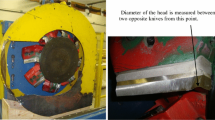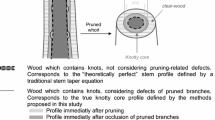Abstract
Fifteen stems of jack pine (Pinus banksiana Lamb.) coming from three commercial thinned (CT) plots (control, moderate, and intensive thinning) in the Abitibi-Témiscamingue region, Canada, were cross-cut into three 2.4 m length sections: bottom, middle, and top logs. Logs were processed with a chipper-canter at three cutting widths (CW 12.7, 19.1, and 25.4 mm), producing chips and a three faced cant. Chips were assessed by thickness, width, and length. Knot characteristics [total knot number (TKN) and area (TKA)] were assessed in the three cant faces. Growth ring attributes [earlywood density, latewood density (LWD), ring density (RD), earlywood proportion (EWP), ring width, and rings per mm], mechanical properties (shear, splitting, modulus of elasticity and modulus of rupture in bending), and basic density were evaluated on samples obtained within each CW area. The weighted mean chip thickness (WCT) was significantly affected by the log position in the stem (LPS) and CW. WCT increased as CW increased. Jack pine produce thicker chips than black spruce, when processed under the same cutting parameters. Thickness of chips coming from bottom and middle logs was similar due to a greater taper of the bottom log, which slightly increased this dimension. Thickest chips were produced in the top log due to a higher TKA and TKN towards the top of the stem. Multiple linear regressions showed that TKA, CW, and RD were significant predictors of WCT. Chip size distributions were significantly affected by the CT, LPS, and CW. Thinned stands logs appeared to produce smaller chips than natural stand logs. Moreover, chip thickness distribution was affected primarily by TKA and EWP, while the width and length distribution was mainly affected by EWP, LWD, and TKN. Chip size in jack pine is to some degree determined by knot attributes, growth ring characteristics, and wood density of the raw material. These results suggest the potential advantage of sorting logs prior to chipping, either by species, LPS and/or provenance (thinned or natural stands).






Similar content being viewed by others
References
Agarwal N, Gustafson R, Arasakesari S (1994) Modeling the effect of chip size in kraft pulping. Pap Tim 76:410–416
Aitchison J (1982) The statistical-analysis of compositional data. J R Stat Soc B Methodol 44:139–177
Alteyrac J, Zhang S, Cloutier A, Ruel J-C (2005) Influence of stand density on ring width and wood density at different sampling heights in black spruce (Picea mariana (Mill.) B.S.P.). Wood Fiber Sci 37:83–94
ASTM D143-94 (2007) Standard test methods for small clear specimens of timber. American Society for Testing Materials, West Conshohocken
Barbour RJ, Fayle DCF, Chauret G, Cook J, Karsh MB, Ran SK (1994) Breast-height relative density and radial growth in mature jack pine (Pinus banksiana) for 38 years after thinning. Can J For Res 24:2439–2447
Bjurulf A (2005) Dimensional consistency of wood chips over time. Nord Pulp Pap Res J 20:43–47
Brill JW (1985) Effects of wood and chip quality on TMP properties. In: Proceedings of the international mechanical pulping conference, Stockholm, 6–10 May 1985. Tappi Press, Atlanta, pp 153–161
Broderick G, Cacchione E, Heroux Y (1998) The importance of distribution statistics in the characterization of chip quality. Tappi J 81:131–142
Buksnowitz C, Hackspiel C, Hofstetter K, Müller U, Gindl W, Teischinger A, Konnerth J (2010) Knots in trees: strain distribution in a naturally optimised structure. Wood Sci Technol 44:389–398
Cáceres CB, Hernández RE, Koubaa A (2015) Effects of the cutting pattern and log provenance on size distribution of black spruce chips produced by a chipper-canter. Eur J Wood Prod 73:357–368
Cáceres CB, Hernández RE, Koubaa A (2016) Effects of log position in the stem and cutting width on size distribution of black spruce chips produced by a chipper-canter. Wood Fiber Sci 48:1–18
Christie RD (1986) Chip thickness and its effect on pulping needs further study. Pulp Pap Can 87:37–43
Colin F, Houllier F (1991) Branchiness of Norway spruce in Northeastern France—modelling vertical trends in maximum nodal branch size. Ann Sci For 48:679–693
Colin F, Houllier F (1992) Branchiness of Norway spruce in Northeastern France—predicting the main crown characteristics from usual tree measurements. Ann Sci For 49:511–538
Ding F, Benaoudia M, Bedard P, Lanouette R (2009) Effects of some wood chip properties on pulp quality. Pulp Pap Can 110:20–23
Duchateau E, Longuetaud F, Mothe F, Ung C, Auty D, Achim A (2013) Modelling knot morphology as a function of external tree and branch attributes. Can J For Res 43:266–277
Duchesne I (2006) Effect of rotation age on lumber grade yield, bending strength and stiffness in jack pine (Pinus banksiana Lamb.) natural stands. Wood Fiber Sci 38:84–94
Duchesne I, Swift DE (2008) Impact of intensive silviculture on wood product quality and value in a jack pine stand. Long-term impact of late commercial thinning at wide spacing. General Revenue Report Project No. 5767. FPInnovations, Quebec, QC, p 49
Duchesne I, Wilhelmsson L, Spångberg K (1997) Effects of in-forest sorting of Norway spruce (Picea abies) and Scots pine (Pinus sylvestris) on wood and fibre properties. Can J For Res 27:790–795
Feiner JH, Gallay W (1962) The effect of chip thickness on sulphite pulp yield and quality. Pulp Pap Can 63:T435–T441
Galloway L, Thomas P (1972) Studies on chip quality from a Chip-N-Saw chipping headrig. Pulp Pap Can 73:82–86
Goudiaby V, Brais S, Berninger F, Schneider R (2012) Vertical patterns in specific volume increment along stems of dominant jack pine (Pinus banksiana) and black spruce (Picea mariana) after thinning. Can J For Res 42:733–748
Hartler N (1996) Achievement and significance of optimal chip quality. Tappi J 79:259–264
Hartler N, Stade Y (1979) Chip specifications for various pulping processes. In: Hatton JV (ed) Chip quality monograph. Joint Textbook Committee of the Paper Industry, Atlanta, pp 273–301
Hatton JV, Keays JL (1973) Effect of chip geometry and moisture on yield and quality of kraft pulps from western hemlock and black spruce. Pulp Pap Can 74:79–87
Hedenberg O (2001) Revision of the standardised method for determination of chip size distribution. Pap Tim 83:142
Heger L (1974) Longitudinal variation of specific gravity in stems of black spruce, balsam fir, and lodgepole pine. Can J For Res 4:321–326
Hernández RE, Boulanger J (1997) Effect of the rotation speed on the size distribution of black spruce pulp chips produced by a chipper-canter. For Prod J 47:43–49
Hernández RE, Lessard J (1997) Effect of cutting width and cutting height on the size distribution of black spruce pulp chips produced by a chipper-canter. For Prod J 47:89–95
Hernández RE, Quirion B (1993) Effect of a chipper-canter knife clamp on the quality of chips produced from black spruce. For Prod J 43:8–14
Hoekstra PL, Veal MA, Lee PF, Sinkey JD (1983) The effects of chip size on mechanical pulp properties and energy-consumption. Tappi J 66:119–122
Kasraoui H (2011) Effets de l’éclaircie commerciale et de la fertilisation sur la masse volumique du bois et sur la morphologie des trachéides du pin gris (Pinus banksiana Lamb.) (Effects of commercial thinning and fertilization on jack pine (Pinus banksiana Lamb.) wood density and tracheid morphology) (in French). Master thesis, Université du Québec à Montréal
Kuljich S, Hernández RE, Blais C (2015) Effects of the cutterhead diameter and log infeed position on the energy requirements of a chipper-canter. Wood Fiber Sci 47:399–409
Lapointe JA (1979) Domtar classifier accurately measures thickness and length of wood chips. Pap Trade J 8:28–30
Law KN, Valade JL (1994) Status of the utilization of jack pine (Pinus banksiana) in the pulp and paper-industry. Can J For Res 24:2078–2084
Lemieux H, Beaudoin M, Zhang SY (2001) Characterization and modeling of knots in black spruce (Picea mariana) logs. Wood Fiber Sci 33:465–475
Lönnberg B, Robertsén L (1986) Significance of chip thickness in CRMP and RMP—a laboratory study with pine chips. Pap Tim 68:36–41
McGovern JN (1979) Chip specifications for various pulping processes. In: Hatton JV (ed) Chip quality monograph. Joint Textbook Committee of the Paper Industry, Atlanta, pp 91–110
McKinnon LM, Kayahara GJ, White RG (2006) Biological framework for commercial thinning even-aged single-species stands of jack pine, white spruce, and black spruce in Ontario. Technical Report TR-046. Ontario Ministry of Natural Resources, South Porcupine
MFFP—Ministry of Forests, Wildlife and Parks (2016) Quebec forest products industry. Quebec Government. https://www.mffp.gouv.qc.ca/forets/quebec/quebec-regime-gestion-developpement.jsp. Accessed 11 May 2016
Olson D, Hatton JV, Hunt K (1980) Effect of chip thickness in kraft-anthraquinone pulping of trembling aspen. Tappi J 63:109–110
Panshin AJ, de Zeeuw C (1980) Textbook of wood technology. McGraw-Hill, New York
Park YI, Koubaa A, Brais S, Mazerolle MJ (2009) Effects of cambial age and stem height on wood density and growth of jack pine grown in boreal stands. Wood Fiber Sci 41:346–358
Rudie AW, Morra J, St Laurent JM, Hickey KL (1994) The influence of wood and fiber properties on mechanical pulping. Tappi J 77:86–90
Schneider R, Zhang SY, Swift DE, Begin J, Lussier JM (2008) Predicting selected wood properties of jack pine following commercial thinning. Can J For Res 38:2030–2043
Shmulsky R, Jones PD (2011) Forest products and wood science: an introduction. Wiley-Blackwell, London
Smith DE, Javid SR (1992) New approaches to fines and pins screening. Tappi J 75:93–97
Smith DM, Larson BC, Kelty MJ, Ahston PMS (1997) The practice of silviculture: applied forest ecology. Wiley, New York
Svedman M, Tikka P, Luhtanen M (1998) Effects of softwood morphology and chip thickness on pulping with a displacement kraft batch process. Tappi J 81:157–168
Tikka P, Tahkanen H (1994) Chip thickness vs kraft pulping performance 3. Effect of new optimized chip quality on continuous cooking, oxygen delignification and bleaching of softwood kraft pulp. In: Tappi proceedings of pulping conference, San Diego, 6–10 November 1994. Tappi Press, Atlanta, pp 177–182
Tikka P, Kovasin K, Tahkanen H (1993) Chip thickness vs kraft pulping performance 2. Effect of chip thickness screening on cooking, oxygen delignification and bleaching of softwood kraft batch pulp. In: Tappi proceedings of pulping conference, Atlanta, 14–18 November 1993. Tappi Press, Atlanta, pp 833–838
Trincado G, Burkhart HE (2008) A model of knot shape and volume in loblolly pine trees. Wood Fiber Sci 40:634–646
Twaddle A (1997) The influence of species, chip length, and ring orientation on chip thickness. Tappi J 80:123–131
Wood JR (1996) Chip quality effects in mechanical pulping—a selected review. In: Tappi proceedings of pulping conference, Nashville, 27–31 October 1996. Tappi Press, Atlanta, pp 491–497
Zhang SY, Koubaa A (2009) Les résineux de l’Est du Canada : écologie forestière, caractéristiques, transformation et usages (Softwoods of Eastern Canada. Their silvics, characteristics, manufacturing and end-uses) (in French). Forintek Canada Corporation, Quebec
Zhang SY, Chauret G, Swift DE, Duchesne I (2006) Effects of precommercial thinning on tree growth and lumber quality in a jack pine stand in New Brunswick, Canada. Can J For Res 36:945–952
Zobel BJ, van Buijtenen JP (1989) Wood variation: its causes and control. Springer, Berlin
Acknowledgments
Funding for this project was provided by the Natural Sciences and Engineering Research Council of Canada (NSERC). The authors thank DK-Spec for providing the chipper canter cutterhead. The authors also thank Daniel Bourgault, Éric Rousseau, Luc Germain, Angela Llavé, and Svetka Kuljich for their valuable assistance.
Author information
Authors and Affiliations
Corresponding author
Rights and permissions
About this article
Cite this article
Cáceres, C.B., Hernández, R.E. & Koubaa, A. Effects of log position in the stem and commercial thinning on jack pine chip dimensions produced by a chipper-canter. Eur. J. Wood Prod. 75, 359–373 (2017). https://doi.org/10.1007/s00107-016-1062-x
Received:
Published:
Issue Date:
DOI: https://doi.org/10.1007/s00107-016-1062-x




